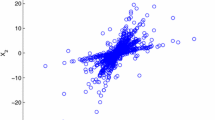Abstract
In this paper, a neural network model and its associate learning rule are developed for sequential blind extraction in the case that the number of observable mixed signals is less than the one of sources. This approach is also suitable for the case in which the mixed matrix is nonsingular. Using this approach, all separable sources can be extracted one by one. The solvability analysis of the problem is also presented, and the new solvable condition is weaker than existing solvable conditions in some literatures.
Access this chapter
Tax calculation will be finalised at checkout
Purchases are for personal use only
Preview
Unable to display preview. Download preview PDF.
Similar content being viewed by others
References
Comon, P.: Independent Component Analysis. A New Concept. Signal Process 36, 287–314 (1994)
Hyvarinen, A., Oja, E.: Independent Component Analysis: Algorithms and Applications. Neural Networks 13, 411–430 (2000)
Bell, A.J., Sejnowski, T.J.: An information-maximization approach to blind separation and blind deconvolution. Neural Comput. 7, 1004–1034 (1995)
Kundur, D., Hatzinakos, D.: A Novel Blind Deconvolution Scheme for Image Restoration Using Recursive Filtering. IEEE Trans. Signal Processing 46, 375–390 (1998)
Comon, P., Jutten, C., Herault, J.: Blind Separation of Sources, Part II: Problems Statement. Signal Process. 24, 11–20 (1991)
Li, Y., Wang, J., Zurada, J.M.: Blind Extraction of Singularly Mixed Source Signals. IEEE Trans. Neural Networks 11, 1413–1422 (2000)
Li, Y., Wang, J.: Sequential Blind Extraction of Instantaneously Mixed Source. IEEE Trans. Signal Processing 50, 997–1006 (2000)
Van Der Veen, A.J.: Algebraic Methods for Deterministic Blind Beamforming. Proc. IEEE 86, 1987–2008 (1998)
Author information
Authors and Affiliations
Editor information
Editors and Affiliations
Rights and permissions
Copyright information
© 2005 Springer-Verlag Berlin Heidelberg
About this paper
Cite this paper
Zeng, Z., Fu, C. (2005). Blind Extraction of Singularly Mixed Source Signals. In: Wang, L., Chen, K., Ong, Y.S. (eds) Advances in Natural Computation. ICNC 2005. Lecture Notes in Computer Science, vol 3610. Springer, Berlin, Heidelberg. https://doi.org/10.1007/11539087_84
Download citation
DOI: https://doi.org/10.1007/11539087_84
Publisher Name: Springer, Berlin, Heidelberg
Print ISBN: 978-3-540-28323-2
Online ISBN: 978-3-540-31853-8
eBook Packages: Computer ScienceComputer Science (R0)




